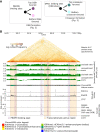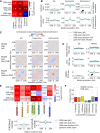Genome-wide variability in recombination activity is associated with meiotic chromatin organization
- PMID: 34301629
- PMCID: PMC8415379
- DOI: 10.1101/gr.275358.121
Genome-wide variability in recombination activity is associated with meiotic chromatin organization
Abstract
Recombination enables reciprocal exchange of genomic information between parental chromosomes and successful segregation of homologous chromosomes during meiosis. Errors in this process lead to negative health outcomes, whereas variability in recombination rate affects genome evolution. In mammals, most crossovers occur in hotspots defined by PRDM9 motifs, although PRDM9 binding peaks are not all equally hot. We hypothesize that dynamic patterns of meiotic genome folding are linked to recombination activity. We apply an integrative bioinformatics approach to analyze how three-dimensional (3D) chromosomal organization during meiosis relates to rates of double-strand-break (DSB) and crossover (CO) formation at PRDM9 binding peaks. We show that active, spatially accessible genomic regions during meiotic prophase are associated with DSB-favored loci, which further adopt a transient locally active configuration in early prophase. Conversely, crossover formation is depleted among DSBs in spatially accessible regions during meiotic prophase, particularly within gene bodies. We also find evidence that active chromatin regions have smaller average loop sizes in mammalian meiosis. Collectively, these findings establish that differences in chromatin architecture along chromosomal axes are associated with variable recombination activity. We propose an updated framework describing how 3D organization of brush-loop chromosomes during meiosis may modulate recombination.
© 2021 Jin et al.; Published by Cold Spring Harbor Laboratory Press.
Figures





Similar articles
-
Genomic and chromatin features shaping meiotic double-strand break formation and repair in mice.Cell Cycle. 2017 Oct 18;16(20):1870-1884. doi: 10.1080/15384101.2017.1361065. Epub 2017 Aug 18. Cell Cycle. 2017. PMID: 28820351 Free PMC article.
-
Variation in genome-wide levels of meiotic recombination is established at the onset of prophase in mammalian males.PLoS Genet. 2014 Jan 30;10(1):e1004125. doi: 10.1371/journal.pgen.1004125. eCollection 2014 Jan. PLoS Genet. 2014. PMID: 24497841 Free PMC article.
-
Recombination correlates with synaptonemal complex length and chromatin loop size in bovids-insights into mammalian meiotic chromosomal organization.Chromosoma. 2017 Oct;126(5):615-631. doi: 10.1007/s00412-016-0624-3. Epub 2017 Jan 18. Chromosoma. 2017. PMID: 28101670
-
Programmed induction of DNA double strand breaks during meiosis: setting up communication between DNA and the chromosome structure.Curr Opin Genet Dev. 2013 Apr;23(2):147-55. doi: 10.1016/j.gde.2012.12.002. Epub 2013 Jan 11. Curr Opin Genet Dev. 2013. PMID: 23313097 Review.
-
After the break: DSB end processing in mouse meiosis.Genes Dev. 2020 Jun 1;34(11-12):731-732. doi: 10.1101/gad.339309.120. Genes Dev. 2020. PMID: 32482713 Free PMC article. Review.
Cited by
-
QTL identification and characterization of the recombination landscape of the mountain pine beetle (Dendroctonus ponderosae).G3 (Bethesda). 2025 Jul 9;15(7):jkaf101. doi: 10.1093/g3journal/jkaf101. G3 (Bethesda). 2025. PMID: 40333319 Free PMC article.
-
Dynamic changes in histone lysine lactylation during meiosis prophase I in mouse spermatogenesis.Proc Natl Acad Sci U S A. 2025 Feb 18;122(7):e2418693122. doi: 10.1073/pnas.2418693122. Epub 2025 Feb 10. Proc Natl Acad Sci U S A. 2025. PMID: 39928879 Free PMC article.
-
PRDM9 losses in vertebrates are coupled to those of paralogs ZCWPW1 and ZCWPW2.Proc Natl Acad Sci U S A. 2022 Mar 1;119(9):e2114401119. doi: 10.1073/pnas.2114401119. Proc Natl Acad Sci U S A. 2022. PMID: 35217607 Free PMC article.
-
Chromosome Organization in Early Meiotic Prophase.Front Cell Dev Biol. 2021 Jun 3;9:688878. doi: 10.3389/fcell.2021.688878. eCollection 2021. Front Cell Dev Biol. 2021. PMID: 34150782 Free PMC article. Review.
-
Deep learning identifies and quantifies recombination hotspot determinants.Bioinformatics. 2022 May 13;38(10):2683-2691. doi: 10.1093/bioinformatics/btac234. Bioinformatics. 2022. PMID: 35561158 Free PMC article.
